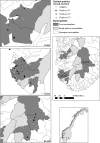Climate and environmental change drives Ixodes ricinus geographical expansion at the northern range margin
- PMID: 24401487
- PMCID: PMC3895670
- DOI: 10.1186/1756-3305-7-11
Climate and environmental change drives Ixodes ricinus geographical expansion at the northern range margin
Abstract
Background: Global environmental change is causing spatial and temporal shifts in the distribution of species and the associated diseases of humans, domesticated animals and wildlife. In the on-going debate on the influence of climate change on vectors and vector-borne diseases, there is a lack of a comprehensive interdisciplinary multi-factorial approach utilizing high quality spatial and temporal data.
Methods: We explored biotic and abiotic factors associated with the latitudinal and altitudinal shifts in the distribution of Ixodes ricinus observed during the last three decades in Norway using antibodies against Anaplasma phagocytophilum in sheep as indicators for tick presence. Samples obtained from 2963 sheep from 90 farms in 3 ecologically different districts during 1978 - 2008 were analysed. We modelled the presence of antibodies against A. phagocytophilum to climatic-, environmental and demographic variables, and abundance of wild cervids and domestic animals, using mixed effect logistic regressions.
Results: Significant predictors were large diurnal fluctuations in ground surface temperature, spring precipitation, duration of snow cover, abundance of red deer and farm animals and bush encroachment/ecotones. The length of the growth season, mean temperature and the abundance of roe deer were not significant in the model.
Conclusions: Our results highlight the need to consider climatic variables year-round to disentangle important seasonal variation, climatic threshold changes, climate variability and to consider the broader environmental change, including abiotic and biotic factors. The results offer novel insight in how tick and tick-borne disease distribution might be modified by future climate and environmental change.
Figures



Similar articles
-
Infection prevalence and ecotypes of Anaplasma phagocytophilum in moose Alces alces, red deer Cervus elaphus, roe deer Capreolus capreolus and Ixodes ricinus ticks from Norway.Parasit Vectors. 2019 Jan 3;12(1):1. doi: 10.1186/s13071-018-3256-z. Parasit Vectors. 2019. PMID: 30606222 Free PMC article.
-
Factors driving the abundance of ixodes ricinus ticks and the prevalence of zoonotic I. ricinus-borne pathogens in natural foci.Appl Environ Microbiol. 2012 Apr;78(8):2669-76. doi: 10.1128/AEM.06564-11. Epub 2012 Jan 27. Appl Environ Microbiol. 2012. PMID: 22286986 Free PMC article.
-
Changes in the geographical distribution and abundance of the tick Ixodes ricinus during the past 30 years in Sweden.Parasit Vectors. 2012 Jan 10;5:8. doi: 10.1186/1756-3305-5-8. Parasit Vectors. 2012. PMID: 22233771 Free PMC article.
-
[Ixodes ricinus, transmitted diseases and reservoirs].Parassitologia. 2004 Jun;46(1-2):119-22. Parassitologia. 2004. PMID: 15305699 Review. Italian.
-
Driving forces for changes in geographical distribution of Ixodes ricinus ticks in Europe.Parasit Vectors. 2013 Jan 2;6:1. doi: 10.1186/1756-3305-6-1. Parasit Vectors. 2013. PMID: 23281838 Free PMC article. Review.
Cited by
-
Environmental and ecological factors affecting tick infestation in wild birds of the Americas.Parasitol Res. 2024 Jun 26;123(6):254. doi: 10.1007/s00436-024-08246-6. Parasitol Res. 2024. PMID: 38922478 Free PMC article.
-
The evolving story of Borrelia burgdorferi sensu lato transmission in Europe.Parasitol Res. 2022 Mar;121(3):781-803. doi: 10.1007/s00436-022-07445-3. Epub 2022 Feb 5. Parasitol Res. 2022. PMID: 35122516 Free PMC article. Review.
-
Aggravation of Human Diseases and Climate Change Nexus.Int J Environ Res Public Health. 2019 Aug 6;16(15):2799. doi: 10.3390/ijerph16152799. Int J Environ Res Public Health. 2019. PMID: 31390751 Free PMC article. Review.
-
Seropositivity of main vector-borne pathogens in dogs across Europe.Parasit Vectors. 2022 Jun 6;15(1):189. doi: 10.1186/s13071-022-05316-5. Parasit Vectors. 2022. PMID: 35668469 Free PMC article.
-
Parasitized or non-parasitized, why? A study of factors influencing tick burden in roe deer neonates.PLoS One. 2022 Jul 18;17(7):e0262973. doi: 10.1371/journal.pone.0262973. eCollection 2022. PLoS One. 2022. PMID: 35849592 Free PMC article.
References
-
- Randolph SE. Tick ecology: processes and patterns behind the epidemiological risk posed by ixodid ticks as vectors. Parasitology. 2004;129(Suppl):S37–S65. - PubMed
-
- Macleod JAJ. The binomics of Ixodes ricinus L.,the “sheep tick” of Scotland. Parasitology. 1932;24:382–400. doi: 10.1017/S0031182000020795. - DOI
Publication types
MeSH terms
LinkOut - more resources
Full Text Sources
Other Literature Sources

